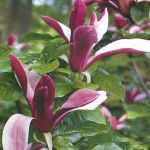| Common Name: |
Lily-flowered Magnolia |
| Botanical Name: |
Magnolia liliiflora syn. M. quinquepeta |
| Genus: |
Magnolia |
| Family: |
Magnoliaceae |
| Native Location: |
Native to China |
| Cultivation: |
Moist, neutral to acid, rich soil in sun or partial shade, with shelter from cold winds and late frosts. Magnolia virginiana tolerates wet soils. Buds and open flowers turn brown when damaged by frost. |
| Propagation: |
By seed sown in autumn (species only); by greenwood cuttings in late summer (deciduous magnolias); by semi-ripe cuttings from late summer to early autumn (evergreen magnolias). |
| Harvest: |
Bark is collected in autumn and dried for use in decoction, liquid extracts, powders, and tinctures. Its aromatic properties do not keep well and stocks are renewed annually. Flower buds and flowers are picked in spring (M. liliiflora) or when open in summer (M. officinalis), an d used fresh or dried in decoctions, or dried for powders. |
| Variations: |
Nigra
Is compact and flowers when young, bearing numerous, deep purple flowers intermittently from spring to autumn.
Width: 2.5m (8ft) |
|
| Height: |
3m (10ft) |
| Width: |
4m (12ft) |
| Hardiness: |
Z6-9 |
| Parts Used: |
Flowers, flower buds (xin yi) |
| Properties: |
A pungent, warming, sedative herb that constricts blood vessels in the nasal passages. It also lowers blood pressure, relieves pain, and has anti-fungal effects. |
| Medicinal Uses: |
Internally for sinusitis, allergic rhinitis, colds with mucus or runny nose. Excess causes dizziness. Incompatible with Astralagus membranaceus (See, Milk Vetch) |
| Bibliography: |
Encyclopedia of Herbs by Deni Brown Copyright © 1995, 2001 Dorling Kindersley Limited Pg 269 |

